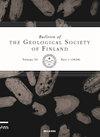Glacial varves at the distal slope of Pandivere-Neva ice-recessional formations in western Estonia
IF 1.3
4区 地球科学
Q2 GEOLOGY
引用次数: 10
Abstract
The distribution and varve thickness data of Late Weichselian varved clay were analyzed to describe the proglacial sedimentary environment, ice recession and water-level changes in the Baltic Ice Lake at the distal position of Pandivere–Neva (13.5–13.1 ka BP) icerecessional formations in western Estonia. According to vertical changes in natural water content, fabric and varve thickness, four clay units were distinguished, reflecting a change in the sedimentary environment from ice-proximal to distal conditions. The varved clay complex is locally interrupted by a massive silty-clay unit, interpreted as an icedrift material during the stagnation of the glacier margin at the Pandivere–Neva line. Varve correlation gave a 294-year-long floating varve chronology. According to total varve thickness and the relation between thicknesses of seasonal layers, an about 130year period of ice-proximal conditions in the study area was followed by a rapid (within ca 20 years) change to more distal conditions. The presented varve chronology does not cover the entire period of proglacial conditions in the area, as all studied clay sections displayed an erosional discontinuity at the upper contact. In total, ca 4 m of selective post-sedimentary erosion of clay is attributed to wave erosion due to a water-level drop after the final drainage of the Baltic Ice Lake. It is concluded that the Yoldia Sea minimum level in the Pärnu area was 0 to –2 m a.s.l.爱沙尼亚西部潘迪维尔-涅瓦冰川消退地层远端斜坡上的冰川裂口
分析了晚Weichselian期变粘土的分布和厚度资料,以描述爱沙尼亚西部Pandivere-Neva (13.5 ~ 13.1 ka BP)冰退地层远端波罗的海冰湖的前冰期沉积环境、冰退和水位变化。根据天然含水量、组构和阀厚的垂直变化,划分出4个粘土单元,反映了沉积环境从冰近端到远端条件的变化。破碎的粘土复合体在局部被一个巨大的粉质粘土单元打断,这被解释为pandiva - neva线冰川边缘停滞期间的冰漂物质。瓣膜相关性给出了294年的浮动瓣膜年表。根据总厚度和季节层厚度之间的关系,研究区冰-近端条件在约130年的周期后迅速(约20年)向远端条件转变。所提出的年代学并不能涵盖该地区前冰期的整个时期,因为所有研究的粘土剖面在上部接触处都显示出侵蚀不连续。总的来说,约4米的选择性沉积后粘土侵蚀可归因于波罗的海冰湖最终排水后水位下降造成的波浪侵蚀。推断Pärnu地区约迪亚海最低水位为0 ~ 2 m a.s.l。
本文章由计算机程序翻译,如有差异,请以英文原文为准。
求助全文
约1分钟内获得全文
求助全文
来源期刊
CiteScore
1.30
自引率
0.00%
发文量
5
审稿时长
>12 weeks
期刊介绍:
Bulletin of the Geological Society of Finland (BGSF) publishes research articles and short communications in all branches of geosciences. Contributions from outside Finland are welcome, provided that they contain material relevant to Finnish geology or are of general interest.

 求助内容:
求助内容: 应助结果提醒方式:
应助结果提醒方式:


